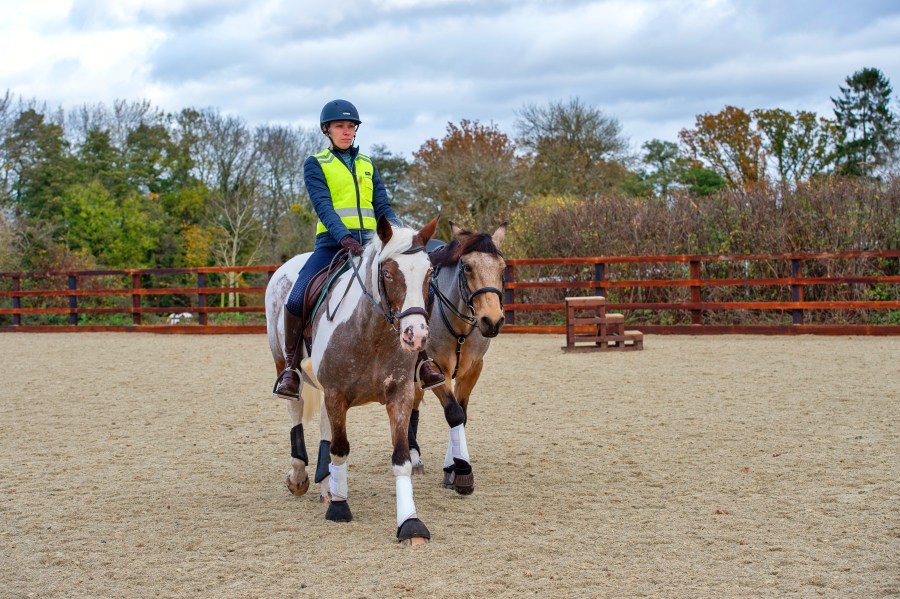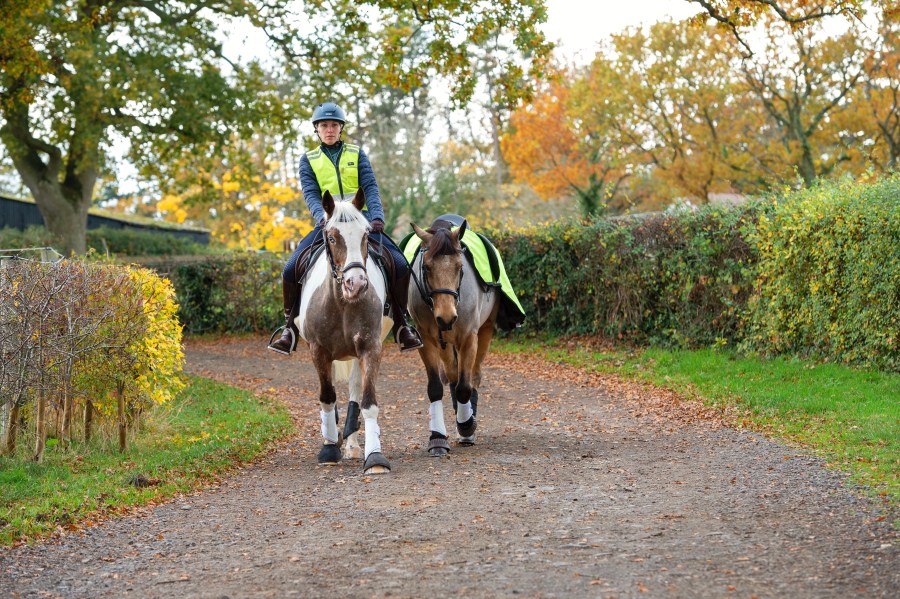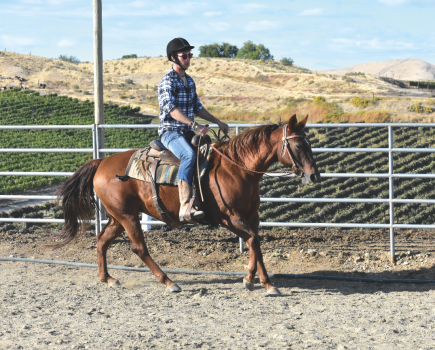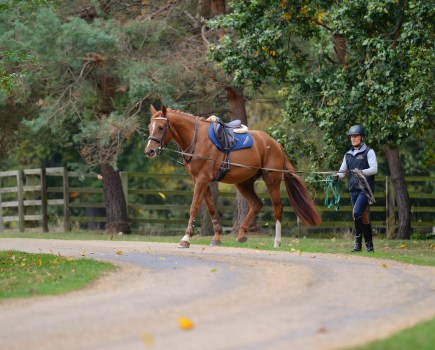In partnership with Equisafety
Sometimes there just aren’t enough hours in the day to ride more than one horse. In this situation, being able to take both out at the same time — riding one and leading the other — is invaluable.
If you’ve ever been to a polo match, you’ll notice that the grooms often ride a pony while leading two or more during the warm up before a game. This is because with so many horses to exercise, it simply isn’t possible to have enough riders to ride each horse. Riding and leading is also commonly seen on big yards where there are lots of horses to exercise every day.
“At a big yard I managed, it was rare for us to hack with only one horse — we had so many to exercise that if you were hacking, you had at least two horses, if not more,” says yard manager and former polo groom Robyn Cherry. “That went for hunters, liveries, polo ponies, everything.”
In polo, it’s normal for a groom to have up to 20 horses to exercise in one day, and that just isn’t possible without doing sets (exercising a group of horses in one go).
“For me, I ride and lead my own two the same time sometimes,” adds Robyn. “Being a groom, it’s hard fitting in your own horses around work, so when I’m short of time, but want to get them out for a good long ride, I take them together by riding one and leading one.”
When it’s useful to ride and lead
Riding and leading is useful in other scenarios too. Maybe your child’s pony needs to go out during school hours but is too small for you to ride, or you’re bringing a horse back into work slowly or waiting for a saddle to be fitted. Of course, it’s also nice to be able to take your child out for a ride without you having to be on foot.
“One of my horses, Bailey, did six months of riding and leading before he got his new saddle, to build up his topline and get his strength back up after not having been ridden for so long,” says Robyn. “I use it for young horses too, to get them out seeing the world, with the steadying influence of an older, more experienced horse at their side. It’s also useful to lead children or inexperienced riders, enabling them to experience a hack, and for nappy horses who prefer hacking with others.”
In fact, riding and leading is such a useful skill that Robyn recommends all riders teach it to their horses, and the younger they start, the better.
“The more horses do it, the better they are,” she says. “If I’m asked to bring on a youngster, I always make sure they get used to both being led and leading. It’s helped me in an awful lot of emergencies.”
Safety first
Once horses understand what is being asked of them, riding and leading is a fairly straightforward skill to learn, but there are safety considerations.
“Always have a bridle on the horse you’re leading,” says Robyn, as it will give you more control than a headcollar will.
“Some people use a lead rope, but I prefer reins. I was taught to loop the reins through the offside bit ring to give you a little more control and to prevent them getting looped around the horse’s nose.”
If you do opt for a lead rope, make sure it is attached to the outside bit ring and threaded through the inside bit ring. This will give you a better contact with your lead horse. Make sure the rope is long enough and that the horse you’re on is steady. You must also be confident riding and steering with one hand before you attempt leading another horse.
“The key when leading is to keep the lead horse’s head at your knee,” advises Robyn. “If the horse you’re leading gets ahead of you, that is where you can start to lose control or have problems with the horses racing each other. Also ensure the reins aren’t looped around your hand, and that you aren’t leaving lots of slack to get caught around your boot or stirrup.”
If, on the other hand, the lead horse drags behind, try a change of pace to trot to enthuse them. Longer term, teaching them to respond to voice cues is vital for this — it’s tricky to carry and use a whip if riding and leading.
Trotting can also help to settle a lead horse that feels spooky or excited. Hold the lead horse’s reins firmly, but never wrap them around your hand. If you know a horse is spooky, ride that one rather than lead — you’ll have more control.
In the UK, we put the lead horse on the left, particularly on the road, as you have more control of the swing of a horse’s quarters if you’re sitting on it.

Always start by practising in the school until you’re comfortable and confident enough to go on a hack.
“It’s a good idea to put overreach boots all round on both horses to start with, as an inexperienced ride and leader, or inexperienced horses, can result in lost shoes if the horses tread on each other,” says Robyn. “I also advise brushing boots on both horses for the same reason. If you will be on the road, wear bright clothing and hi-vis — on you and both horses — to ensure you are clearly seen.”
How to ride and lead safely
1. Start in an enclosed space at a slow pace.
Practise first in a safe area at walk. Practise circles, stopping, starting, and sharp turns in both directions. Both horses need to be calm and confident around other horses as they will be in close proximity, and any scraps could put the rider in danger. Horses that know each other and are either stabled next door or turned out together tend to ride and lead well as a pair.
2. Increase the speed – but only when you’re ready.
Once confident in walk, progress to trot, and make sure you’re confident doing the same shapes and turns in trot. Stay relaxed, keep your shoulders straight (some grooms who ride and lead a lot get back problems from twisting), and keep your left arm at your side.
3. Practise using the brakes.
To stop, simply put a little pressure on the lead horse’s reins — they should stop when the ridden horse does.
4. Learn how to turn.
To turn left, use rein pressure to slow the lead horse a little, then turn the ridden horse across their path.
To turn right, turn the ridden horse and gently guide the lead horse around with you using the reins.
5. Use your hand signals.
The final thing to practise before going out on the roads is hand signals. Practise holding both sets of reins in each hand, and giving signals to turn right and left, slow down, and give thanks to drivers. If drivers don’t know what you’re doing, nobody is safe. This comes with practice, so spend a while in the school or riding around the yard before you tackle the open road.
6. Progress to the canter.
The next stage is cantering. This is where a lot of people come unstuck as horses can get excited.
“I would recommend only very experienced people ride and lead in canter,” says Robyn. “A relaxed, collected canter is key. Again, practise in the school or an enclosed field, and don’t allow the lead horse’s head to pass your knee. Take a friend on foot who can help if things go wrong. Be 100% confident before you try it and, crucially, stay within your comfort zone.”
How to get on and off
In an ideal world, you’ll mount your ridden horse and a helper will pass you the lead rope for the lead horse. But if no such helpers are available, here’s how to do it…
- Place your mounting block where you have plenty of room, not up against a wall or in a tight corner.
- Walk both horses up to the mounting block, one on either side of you. Your ridden horse should be on your right and your lead horse should be on your left, and they should be separated by you and the mounting block, which should now be in the middle.
- Use the mounting block to get on your ridden horse as usual. The only difference is that as you put your reins into your left hand, you should now have the lead horse’s reins in your left hand too.
- At this moment, your horses should be stood almost parallel to each other with a mounting block in the middle of them. Once you are on, you can simply walk them both forward and away you go.
- Another method is to stand your lead horse at a right angle to you, rather than parallel, to give you room to mount your ridden horse. This can be a good method if you need to keep your horses under closer control.
- Again, once you have mounted, walk both horses forward and away from the mounting block.
- When dismounting, position your lead horse at a right angle from the ridden horse so that you have room to dismount. Place both sets of reins in your left hand and dismount.
Ride and lead: Key points
- If you choose to lead with a lead rope, make sure it is attached to the outside bit ring and threaded through, not just the inside ring.
- Don’t allow the lead horse’s head to get in front of your knee.
- Ride with the lead horse on your left.
- Consider putting over-reach and brushing boots on both horses.
- You and both horses should wear high vis.
- Pick horses who know and like each other.
- Don’t try to go too fast – walk and trot is best.
Case study: ‘I sleep better knowing they’ve both had some exercise’
Riding and leading is essential to Katie Palmer being able to exercise her two ex-racehorses in the winter.
“We have very little turnout because the clay ground gets too wet and boggy. The boys are loose in a yard during the day and stabled overnight, and they enjoy a daily ride,” says Katie, who owns 18-year-old chestnut Peter plus 12-year-old Blue.
“Sometimes I just hack out for half an hour and then stand and let them graze for half an hour, then hack home. Other days we go further, and I always vary the route.
“Blue mostly hacks but will do a few days trail hunting and then fun rides in the summer, so I like to keep him semi fit. Peter is retired due to an old injury, so he doesn’t go out every day but I think he likes to have a ‘job’. I know when he doesn’t want to come, because he disappears into his stable when I start tacking up.
“They live as a pair so they’re easy to ride and lead, even though Peter is five inches bigger than Blue at 17.2hh. I would ride and lead when they were competing, so they’ve been doing it for a long time.
“I’ve always ridden and led horses. I pair horses with a similar stride length to avoid one lagging behind, and make sure they like each other. I prefer to lead using a lunge rein, too, so that I know that whatever happens, I won’t lose the lead horse. The trick is carrying it so that it doesn’t get too long or in a tangle.
“We walk, trot and canter. Cantering can get a bit exciting with the two of them next to each other, so I avoid going fast in open spaces and stick to tracks. I sleep better knowing that they have both had some exercise.”
Meet the expert: Robyn Cherry is yard manager at Tyre Hill Equestrian in Worcestershire. She began working on a racing yard aged 14 and has gone on to run her own yard, and to manage others of all sizes — including 300-horse equestrian centres. She holds the RDA equivalent of a BHSAI, and specialises in rehabilitating horses post-intensive care and post-injury.
This content is brought to you in partnership with Equisafety, high viz clothing for horses and riders.








